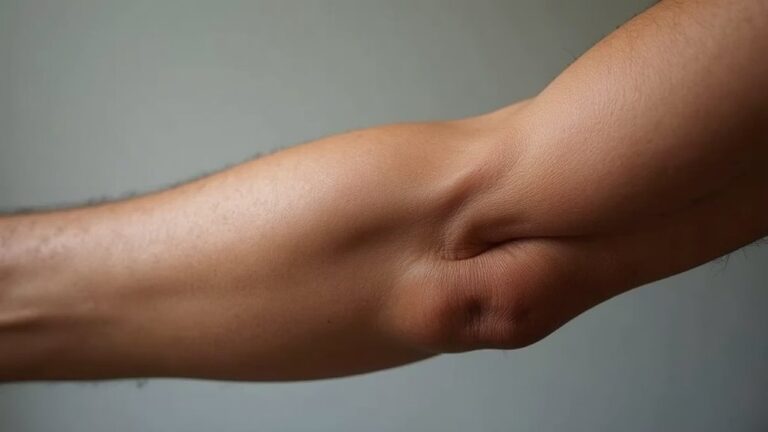Triceps tendonitis occurs when the tendon connecting the triceps muscle to the elbow becomes inflamed, often due to overuse, sudden strain, or repetitive motions like weightlifting or throwing. Pain at the back of the elbow, stiffness, and weakness upon extending the arm are common signs. While mild cases improve with rest and ice, severe damage might require medical intervention.
What Is Triceps Tendonitis?
Ever pondered what causes that nagging pain at the back of the elbow after lifting weights or doing repetitive arm movements? It could be triceps tendonitis, an inflammation of the tendon connecting the triceps muscle to the elbow.
The triceps, running from the shoulder to the elbow, provides strength for pushing and extending the arm. When overused or strained, tiny tears in the tendon can trigger pain, swelling, and stiffness. Activities like weightlifting, throwing, or manual labor often contribute to this condition.
While discomfort usually centers near the elbow, it may radiate toward the shoulder. Prompt treatment—like rest, ice, and gentle stretches—can prevent worsening inflammation. Ignoring the pain risks chronic issues, so heeding the body is key. Comprehending the problem helps in seeking the right care.
Common Causes of Triceps Tendonitis
Triceps tendonitis frequently arises from overuse and repetitive motions, such as lifting or pushing activities.
A sudden impact or injury to the tendon can also instigate inflammation and pain. Additionally, chronic health conditions might weaken the tendon over time, rendering it more prone to irritation.
Overuse and Repetition
Because the triceps tendon absorbs significant stress during repetitive motions, overuse is one of the most frequent causes of tendonitis in this area. Activities like repetitive pushing, pulling, or lifting—common in sports or manual labor—place constant strain on the tendon, leading to microtears and inflammation.
Job-related overuse, such as construction work or assembly line tasks, can gradually wear down the tendon without proper rest. Similarly, athletes who accelerate activity too quickly, like increasing weightlifting intensity or throwing frequency, might outpace the tendon’s ability to adapt. Even everyday actions, like painting or moving furniture, can contribute if done repeatedly without breaks.
The tendon needs time to recover; without it, small damage accumulates, eventually causing pain and stiffness. Recognizing these patterns assists in preventing long-term issues.
Traumatic Injury Impact
While overuse frequently leads to triceps tendonitis, sudden trauma can also trigger painful inflammation in the tendon. A direct blow to the back of the elbow or a fall can cause partial or complete tendon tears, causing the tendon to swell and become tender. This traumatic impact might also strain the shoulder joint if force travels upward. Activities like heavy lifting or abrupt movements can further inflame the tendon, worsening the injury.
| Trauma Type | Effect on Triceps Tendon |
|---|---|
| Direct blow | Immediate swelling, potential tears |
| Fall onto arm | Sudden strain, possible rupture |
| Heavy lifting mishap | Overloads tendon, causing micro-tears |
| Sudden jerking motion | Stresses tendon, leading to inflammation |
Prompt action—like rest and ice—helps prevent long-term damage after such injuries.
Chronic Conditions Influence
Persistence of certain health issues can quietly set the stage for triceps tendonitis, even without the usual strain or injury. Chronic conditions like diabetes, rheumatoid arthritis, and gout often weaken connective tissue over time.
In diabetes, advanced glycation end-products stiffen tendons, making them prone to degeneration. Rheumatoid arthritis triggers chronic inflammation, damaging the triceps tendon. Gout deposits uric acid crystals, causing sharp pain and swelling.
Metabolic syndromes and endocrine disorders also disrupt tendon health, while bone spurs might irritate nearby tissues. These inherent issues create a perfect storm for tendonitis, often without obvious trauma.
Recognizing these silent contributors helps in prompt intervention, preventing worsening pain or limited mobility. Addressing the root cause, not just symptoms, is key to effective long-term relief.
Recognizing Symptoms of Triceps Tendonitis
Pain and discomfort at the back of the elbow are key signs of triceps tendonitis, often worsening with pushing or pulling motions.
Swelling or redness around the area could appear, accompanied by weakness in the arm or shoulder. These symptoms can interfere with daily activities, making timely recognition vital for proper care.
Pain and Discomfort
As the triceps tendon becomes inflamed, discomfort often centers around the elbow, though it can also radiate toward the shoulder or the back of the arm. Pain typically worsens during activities like pushing or pulling, where the triceps bear significant strain.
Inflammation can restrict the arm’s range of motion, making simple tasks challenging. While redness or swelling may accompany the pain, deeper issues like tendon tears or osteoarthritis might produce similar symptoms. Some notice a dull ache at rest, while others feel sharp twinges when moving.
Persistent weakness in the muscle is another red flag. Recognizing these signs promptly helps differentiate tendonitis from more severe conditions, guiding timely care. Ignoring discomfort risks further injury, complicating recovery.
Swelling and Weakness
Swelling and weakness often accompany the discomfort of triceps tendonitis, signaling deeper irritation in the tendon. Inflammation and micro-tears in the tendon can lead to visible puffiness around the elbow, making simple movements like elbow extension painful or difficult.
The triceps muscle might feel weak, especially when pushing objects or straightening the arm. This weakness stems from the tendon’s reduced ability to transfer force due to damage. Activities like lifting or throwing often exacerbate these symptoms.
Should swelling persist or weakness interfere with daily tasks, medical evaluation is pivotal to confirm the diagnosis and guide treatment. Early intervention can prevent further damage and help restore strength, reducing the risk of long-term issues. Proper care ensures a smoother recovery.
How Triceps Tendonitis Is Diagnosed
How can someone know whether their elbow pain is triceps tendonitis? A doctor typically starts with a physical examination, checking for swelling, pain, and range of motion in the elbow. They can press on the tendon or ask the patient to perform specific movements to reproduce pain and pinpoint the location of pain.
To confirm the diagnosis and assess the extent of tendon damage, diagnostic imaging like X-rays, ultrasound, or MRI scans could be used. A DASH questionnaire can also help measure how much the pain affects daily activities. Early diagnosis is key to preventing further injury and starting the right treatment. By combining these methods, healthcare providers can accurately identify triceps tendonitis and rule out other conditions.
Non-Surgical Treatment Options
As elbow pain points to triceps tendonitis, several non-surgical treatments can help ease discomfort and promote healing. Rest is indispensable to avoid further strain, while ice reduces swelling when applied for 15-20 minutes at a time. Compression with a bandage and elevation can also minimize inflammation.
Over-the-counter anti-inflammatory medications, like ibuprofen, could relieve pain. Physical therapy plays a key role, using targeted exercises to strengthen and stretch the triceps, improving flexibility and speeding up recovery. In more stubborn cases, corticosteroid injections might be used to reduce severe inflammation temporarily.
These approaches, whenever combined, help most people recover without surgery. Consistency with treatment and avoiding activities that aggravate the tendon are essential for long-term healing.
Surgical Treatment for Severe Cases
Should non-surgical treatments fail to bring solace after several months, surgery could become essential for severe triceps tendonitis, particularly if the tendon is partially or entirely torn. A triceps tendon rupture often requires tendon repair to reconnect the damaged tissue to the elbow bone.
The procedure is performed under general anesthesia, and post-surgery, the arm is immobilized in a splint to protect the healing tendon. Recovery involves gradual physical therapy or occupational therapy to restore strength and mobility. While most patients regain function within 3–6 months, surgical complications like rerupture occur in rare cases.
Following medical guidance during recovery minimizes risks and improves the end result. Though surgery is a last resort, it can effectively restore function when other treatments fall short.
Prevention and Recovery Strategies
While surgery can restore function in severe cases of triceps tendonitis, many people can avoid reaching that point with the right prevention and recovery strategies. A proper warm-up before exercise prepares the tendon for activity, reducing strain. Gradually increasing workout intensity—rather than sudden jumps—helps prevent overuse.
Strengthening the triceps and shoulder muscles improves tendon resilience, while eccentric strengthening exercises, like slow triceps extensions, aid recovery. Modifying activities, such as avoiding heavy lifting or repetitive motions, eases stress on the tendon. Rest and recovery between workouts are essential to prevent reinjury. Listening to the body and stopping at the initial sign of pain can make a big difference. These steps, combined with patience, help keep the triceps tendon healthy and functional.




